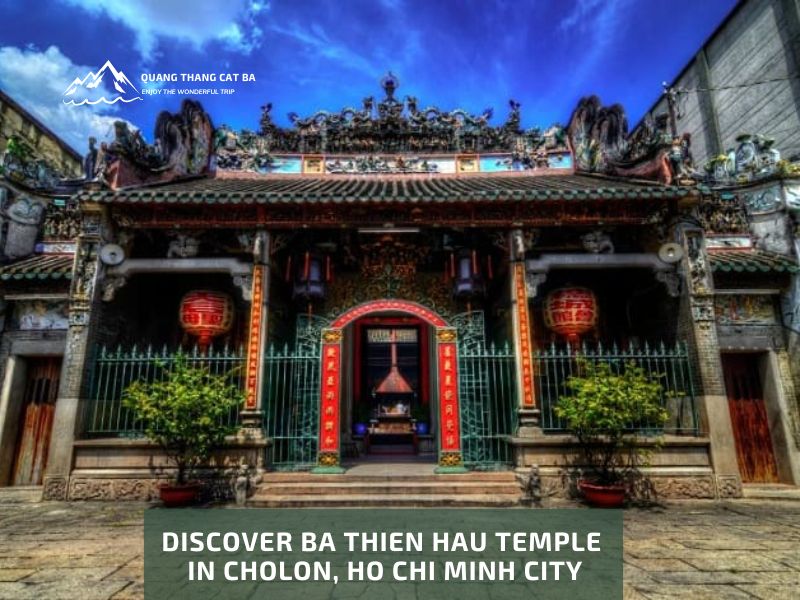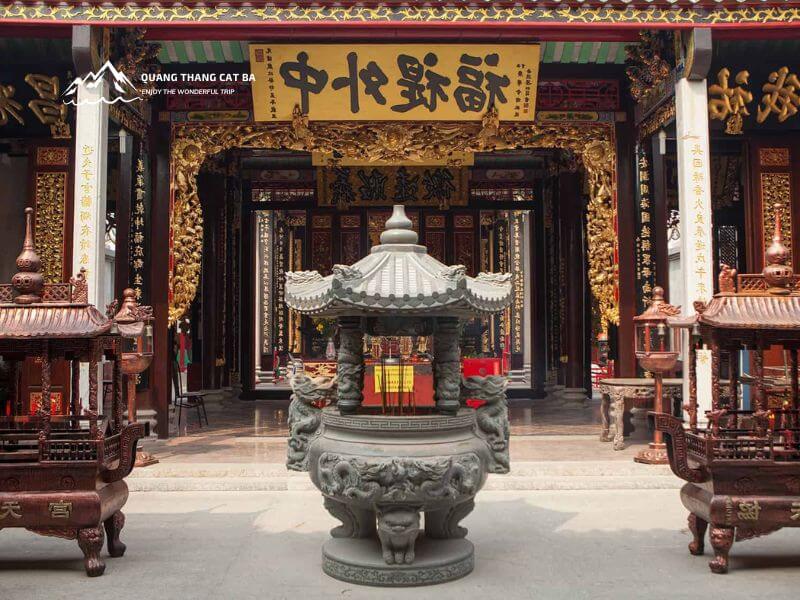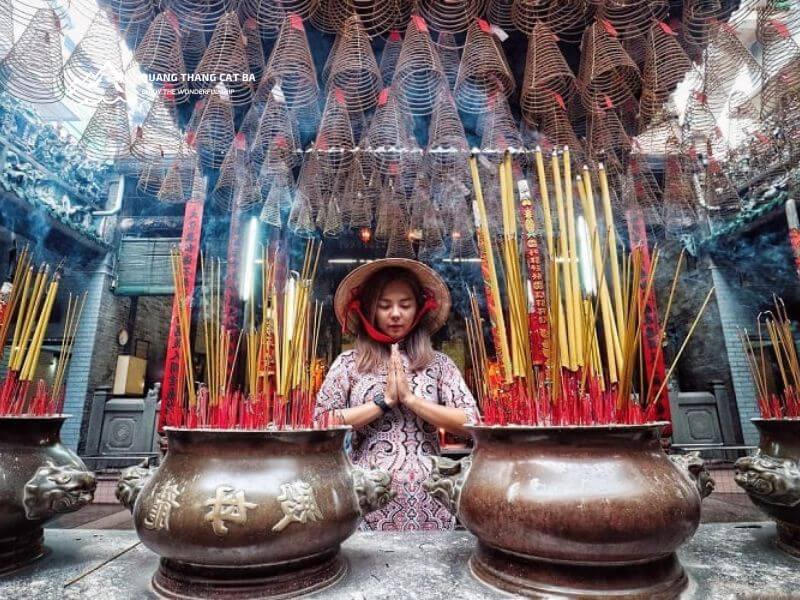Ba Thien Hau Temple, nestled in the vibrant Cholon district of Ho Chi Minh City, stands as a remarkable testament to the cultural and spiritual heritage of the Chinese-Vietnamese community. Established in 1760, this temple is dedicated to Mazu, the revered Goddess of the Sea, celebrated for her protection of sailors and fishermen.
Adorned with intricate porcelain figurines and vibrant decorations, the temple's architecture reflects centuries of tradition and artistry. Beyond its beauty, it plays a vital role in the community through religious ceremonies, festivals, and the preservation of cultural practices.
This article delves into the temple’s historical origins, architectural marvels, and cultural significance, offering a glimpse into its enduring role as a beacon of spirituality and tradition.

What Makes Ba Thien Hau Temple Unique?
A Sacred Landmark in Cholon
Ba Thien Hau Temple serves as a vibrant cultural and spiritual hub in Cholon, the bustling Chinatown of Ho Chi Minh City. Established in the 1760s by Cantonese merchants, it reflects the deep historical ties between the Chinese diaspora and Vietnam.
Key highlights of its uniqueness:
- Cultural significance: The temple is a gathering spot for community events and celebrations, preserving traditions amidst modernization.
- Architectural beauty: Traditional Chinese designs with intricate carvings and vibrant colours showcase its heritage.
- Historical value: Recognized as a National Architectural and Artistic Monument since 1993.
Honouring the Goddess of the Sea
Dedicated to Mazu, the Goddess of the Sea, Ba Thien Hau Temple carries profound religious importance. It provides a sacred space for locals, especially those connected to maritime activities, to express gratitude and seek protection.
Why this worship matters:
- Relevance to livelihoods: Mazu’s protection is crucial for sailors and fishermen.
- Community celebrations: Mazu's birthday (23rd of the third lunar month) features vibrant rituals and parades, strengthening communal bonds.
- Living traditions: Rituals here connect devotees to their spiritual roots and foster identity within the community.
Ba Thien Hau Temple’s cultural and spiritual roles make it a standout landmark in Cholon, blending historical richness with living traditions. It is a testament to the enduring heritage of the Chinese-Vietnamese community.
Historical Insights into Ba Thien Hau Temple

Origins and Early History
Established in 1760 by the Cantonese community, Ba Thien Hau Temple emerged as a spiritual haven for the Chinese diaspora in Cholon, Ho Chi Minh City. Built to honour Mazu, the Goddess of the Sea, it reflected the maritime roots of its patrons. This sacred site also fostered cultural unity, becoming a vital hub for religious and community activities.
Renovations and Cultural Evolution
Ba Thien Hau Temple has undergone notable renovations in 1800, 1842, and 1916, preserving its structure while adapting to Vietnam's cultural evolution. Each restoration blended traditional Chinese designs with Vietnamese influences, symbolising the harmonious interaction of the two cultures. Recognised as a National Artistic Monument in 1993, the temple remains a cornerstone of local heritage and a hub for celebrations.
The temple’s history embodies a blend of tradition and adaptation, showcasing its enduring significance in Vietnam's cultural tapestry.
Architectural Highlights of Ba Thien Hau Temple
Ba Thien Hau Temple (Cre by: Richard Nomad)
Exterior Features
The exterior of Ba Thien Hau Temple captivates visitors with its intricately adorned roof, featuring porcelain figurines depicting Chinese myths and legends. Vibrant lanterns and wooden models of traditional Chinese theaters adorn the entrance, creating a warm and inviting atmosphere. The temple's unique seal-shaped layout showcases traditional Chinese building techniques, where bricks are carefully placed without plaster for a sturdy structure.
Interior Details
Inside, the partially covered courtyard leads to Mazu’s altar, surrounded by porcelain bas-reliefs that vividly portray life in the 19th century. The colourful figures of actors, traders, and mythical creatures tell rich cultural stories. Incense burners and decorative roof designs add to the serene ambiance, making the temple a visually stunning and spiritual haven for worshippers and tourists alike.
The Main Hall and Altars
At the heart of the temple lies the Main Hall, home to a prominent statue of Mazu flanked by Kim Hoa Goddess and Long Mau Goddess. These deities are adorned with luxurious embroidered robes, symbolising divine protection and guidance. The altars, laden with meaningful artifacts, serve as focal points for devotion, reinforcing the temple's role as a sacred space of blessings and spiritual connection.
Ba Thien Hau Temple's exquisite architecture combines beauty, history, and spiritual depth, making it an essential destination for those seeking cultural and religious insights in Ho Chi Minh City.
Religious and Cultural Significance

Role in the Local Community
Ba Thien Hau Temple acts as a cultural and spiritual hub for the Chinese-Vietnamese community in Cholon. It fosters unity through shared religious rituals and community events, preserving traditions for future generations. Locals gather here to pray for safety, prosperity, and guidance, reinforcing its importance in their spiritual journeys and cultural identity.
Festivals and Celebrations
The temple hosts vibrant festivities, with Mazu’s birthday on the 23rd day of the third lunar month as the highlight. This celebration includes traditional processions, music, and dance, attracting large crowds. Other ceremonies, like Lunar New Year offerings, provide worshippers with opportunities to seek blessings, making the temple a focal point for cultural expression and spiritual renewal.
Ba Thien Hau Temple stands as a testament to the enduring cultural and spiritual traditions of the Chinese-Vietnamese community, offering visitors a glimpse into their vibrant heritage.
Visitor Information
`
Map of Ba Thien Hau Temple
Opening Hours and Entrance Fees
Ba Thien Hau Temple welcomes visitors daily from 8:00 AM to 5:00 PM, offering a serene experience throughout the day. Admission is free, making it an accessible destination for exploring its cultural and spiritual heritage. Visitors are encouraged to take their time to appreciate the temple's architectural beauty and sacred atmosphere.
Tips for Visitors
Ensure a meaningful and respectful visit with these simple tips:
- Respect the Sacred Space: Keep your voice low and avoid disruptive actions in this place of worship.
- Photography Etiquette: Photos are allowed, but avoid capturing rituals or individuals without permission.
- Dress Appropriately: Modest clothing covering shoulders and knees is recommended.
- Observe Rituals: Watching rituals enhances understanding of local culture and beliefs.
By adhering to these guidelines, visitors can enjoy an enriching experience while honouring the temple's cultural significance.
Frequently Asked Questions (FAQs)
What is the history of Ba Thien Hau Temple?
Built in 1760, Ba Thien Hau Temple stands as a cultural icon for the Chinese community in Ho Chi Minh City. It symbolises the enduring legacy of Chinese immigrants, who established this sacred site to honour Mazu, the Goddess of the Sea, reflecting their spiritual and maritime roots.
What makes Ba Thien Hau Temple unique?
The temple is distinguished by its porcelain architecture, vibrant decorations, and devotion to Mazu, creating a blend of artistic and cultural significance. Its intricate design and role as a community hub make it a must-visit landmark that embodies traditional beliefs and creative expression.
Are there other similar temples nearby?
Yes, nearby sites like Quan Am Pagoda and clan association temples in Cholon offer rich cultural and religious experiences. These temples showcase the deep-rooted traditions of the Chinese-Vietnamese community and provide additional opportunities for exploration.
When is the best time to visit Ba Thien Hau Temple?
The best time to visit is during Mazu’s birthday celebrations on the 23rd day of the third lunar month, featuring lively processions, music, and rituals. This festive period offers a deeper insight into the temple’s cultural and spiritual significance.
These FAQs provide practical insights to enrich your visit to Ba Thien Hau Temple, highlighting its history, uniqueness, and nearby attractions.
You can explore more information about tourist attractions in Ho Chi Minh City and Vietnam on the travel information map above.
Discover the beauty of Ba Thien Hau Temple and immerse yourself in its cultural charm. Plan your next getaway to Northern Vietnam with Quang Thang Cat Ba at quangthangcatba.com.

